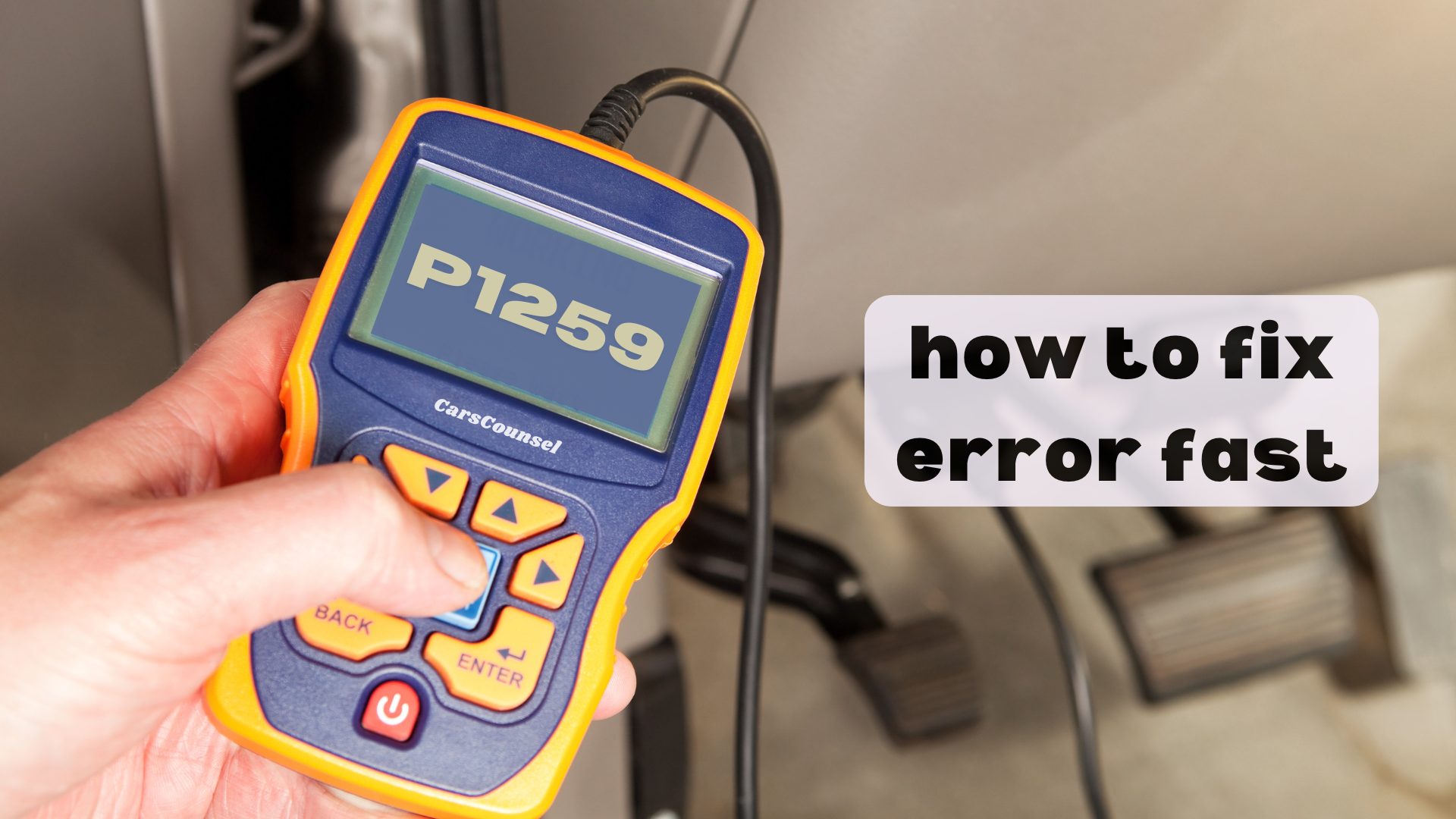You’re probably here because your car’s onboard computer has thrown the P1259 code, indicating a malfunction in the VTEC system. That’s bad news, as a faulty VTEC system can lead to poor engine performance, decreased fuel efficiency, and increased emissions.
But don’t worry, you’re taking the first step towards fixing the issue. The question is, what’s causing the problem?
Is it a simple issue like low engine oil levels, or something more complex like a faulty VTEC solenoid or engine mechanical problem? Let’s examine the possible causes and symptoms together to get your car running smoothly again.

Quick Navigation
Key Takeaways
- A P1259 code indicates a malfunction in the Variable Valve Timing and Lift Electronic Control (VTEC) system, affecting engine performance and efficiency.
- Common causes of VTEC malfunction include low engine oil level, faulty VTEC solenoid, wiring or electrical issues, and engine mechanical problems.
- Symptoms of a faulty VTEC system include loss of power, engine hesitation, poor fuel economy, rough idling, and stalling or engine shutdown.
- Diagnosing and repairing a P1259 code requires checking engine oil levels, inspecting wiring and connections, testing the VTEC pressure switch, and performing a comprehensive engine diagnostic.
- Regular oil maintenance, using the correct oil weight and viscosity, and inspecting and testing VTEC system components are essential to prevent premature wear and malfunction.
Code P1259 Description and Function
Your Honda’s onboard computer has triggered the error code, indicating a malfunction in the Variable Valve Timing and Lift Electronic Control (VTEC) system.
This technology, developed by Honda, refines engine performance by adjusting the timing and lift of the intake valves. When functioning correctly, the VTEC system optimizes engine performance, fuel efficiency, and emissions.
However, a malfunction can lead to poor engine performance, decreased fuel efficiency, and increased emissions. As a result, it’s essential to address the issue promptly to prevent further damage.
Understanding the VTEC system’s function and importance will help you better comprehend the necessary repairs to get your vehicle running smoothly again.
Common Causes of VTEC Malfunction
With the P1259 code triggered, it’s essential to identify the root cause of the VTEC system malfunction.
As you examine the issue, you’ll want to ponder the common causes of VTEC malfunction that can impact engine performance.
Some potential causes to investigate:
- Low engine oil level or dirty oil
- Faulty VTEC solenoid
- Wiring or electrical issues
- VTEC pressure switch malfunction
- Engine mechanical problems
These issues can affect the proper functioning of the VTEC sensors, leading to poor engine performance and decreased fuel efficiency.
Symptoms of a Faulty VTEC System
When the VTEC system malfunctions, it can manifest in various ways that affect your driving experience. You may notice performance issues, such as engine hesitation, loss of power, or poor acceleration. Additionally, you might experience poor fuel economy, rough idling, or stalling. The check engine light may also illuminate on your dashboard.
| Symptom | Description |
|---|---|
| Loss of Power | Engine struggles to accelerate or maintain speed |
| Engine Hesitation | Delayed engine response when accelerating |
| Poor Fuel Economy | Decreased gas mileage or increased fuel consumption |
| Rough Idling | Engine misfires or stumbles when idling |
| Stalling | Engine shuts off unexpectedly while driving |
Diagnosing and Repairing P1259 Code
Diagnosing and repairing the P1259 code requires a systematic approach to identify the root cause of the VTEC system malfunction.
To get started, you’ll need to check the basics, such as engine oil levels and wiring connections.
- Check engine oil levels and top up if necessary
- Inspect wiring and connections for damage or corrosion
- Test the VTEC pressure switch and replace if faulty
- Perform a comprehensive engine diagnostic to identify underlying mechanical problems
- Consider consulting factory service manuals for more information on VTEC system repair
VTEC Solenoid and Pressure Switch
The VTEC solenoid and pressure switch are critical components of the VTEC system, responsible for controlling valve timing and lift.
As you diagnose the P1259 code, you’ll need to inspect and test these components to identify any faults. Start by performing Solenoid Testing to verify it’s functioning correctly. If you find any issues, replace the faulty solenoid with a new one.
Next, inspect the Pressure Switch Cleaning to certify it’s free from dirt and debris that may affect its performance. Clean the switch thoroughly to restore its function.
Remember to consult your repair manual for specific testing and cleaning procedures to guarantee accuracy and precision.
Engine Oil and VTEC System Relation
After inspecting the VTEC solenoid and pressure switch, it’s time to examine the often-overlooked yet vital relationship between engine oil and the VTEC system.
You might wonder how engine oil affects the VTEC system, but it’s essential to understand that oil viscosity and filter maintenance play a significant role in the system’s performance.
- Oil viscosity affects the VTEC system’s hydraulic pressure, which can impact valve timing and lift.
- A dirty or low oil level can cause the VTEC system to malfunction, leading to poor engine performance and decreased fuel efficiency.
- Regular filter maintenance is vital to prevent contaminants from entering the VTEC system.
- Using the correct oil weight and viscosity is essential for peak VTEC system performance.
- Neglecting oil maintenance can lead to premature wear on VTEC system components, resulting in costly repairs.
Cost and Labor Estimates for Repair
Your vehicle’s repair cost for a P1259 code malfunction will depend on the underlying cause of the issue, which can range from a simple oil change to more complex and expensive repairs, such as replacing faulty VTEC system components.
| Repair Type | Repair Estimates | Labor Costs |
|---|---|---|
| Oil Change | $20-$50 | $30-$60 |
| VTEC Solenoid Replacement | $100-$300 | $150-$300 |
| Wiring or Electrical Repairs | $200-$500 | $300-$600 |
Keep in mind that these estimates are rough and may vary depending on your location, the mechanic’s expertise, and the extent of the repairs needed. It’s essential to get a detailed quote from a trusted mechanic to get an accurate estimate of the repair costs.
Additional Resources and Next Steps
Diagnosing and repairing a P1259 code malfunction can be a complex process, and having access to the right resources is crucial to getting your vehicle back on the road quickly and efficiently.
To guarantee you’re well-equipped to tackle the repair, consider the following resources and next steps:
- Consult factory service manuals for detailed repair guides and diagrams
- Seek professional assistance from a qualified mechanic or repair shop
- Research local repair shops and compare labor rates to find the best option
- Check online forums and repair communities for advice from others who’ve faced similar issues
- Consider purchasing a scan tool or code reader to help diagnose and troubleshoot the issue
More OBD-II Codes
| P1255 | P1256 | P1257 | P1258 |
| P1254 | P1253 | P1252 | P1251 |
| P1116 | P1115 | P1114 | P1111 |
| P1112 | P1104 | P1110 | P1103 |
| P1120 | P1172 | P1690 | P1662 |
| P1654 | P1653 | P1565 | P1555 |
Conclusion
As you navigate the complex landscape of your engine’s performance, a faulty VTEC system can be a ticking time bomb, waiting to trigger a cascade of problems. Don’t let it detonate – address the P1259 code promptly. By understanding the causes, symptoms, and repair options, you’ll be well-equipped to defuse the issue and get your engine running smoothly again. With the right tools and knowledge, you’ll be back on the road in no time, leaving the VTEC malfunction in the dust.

